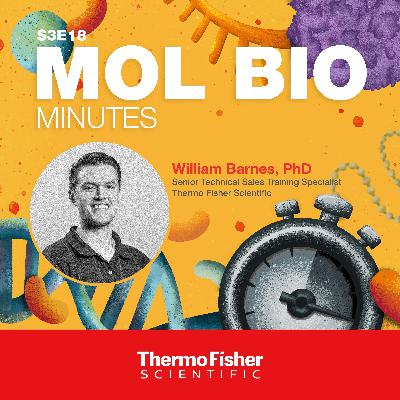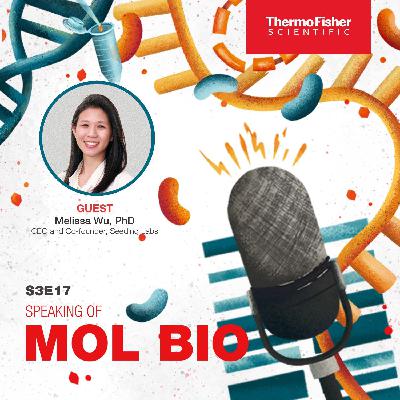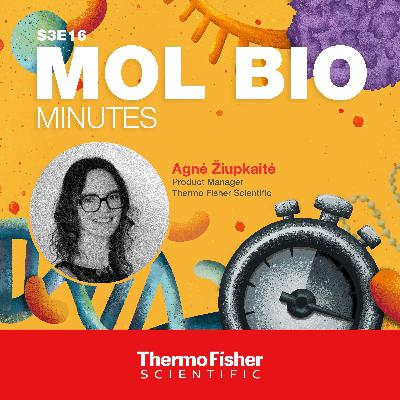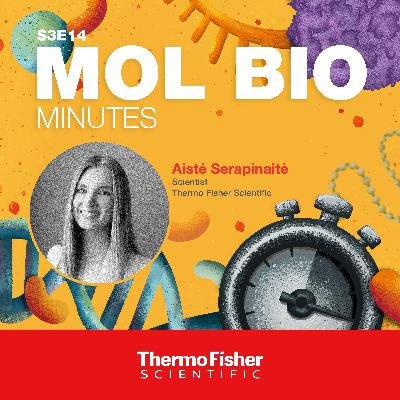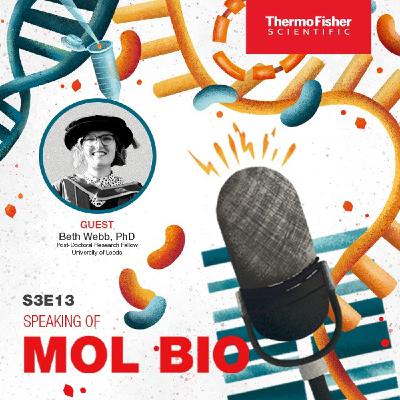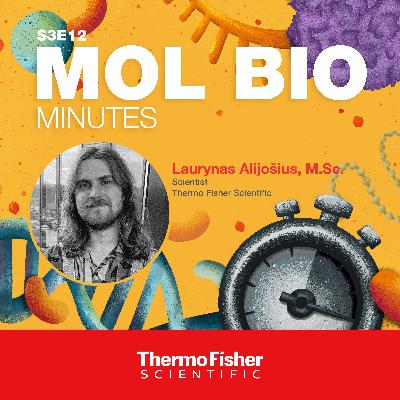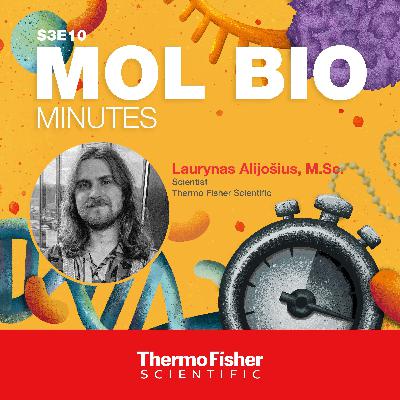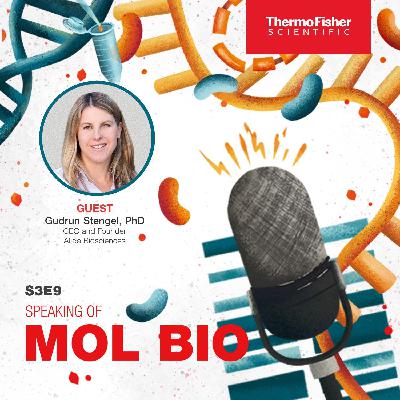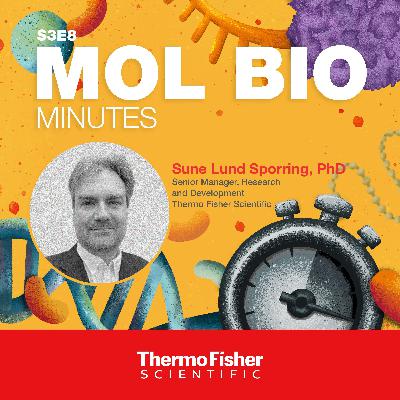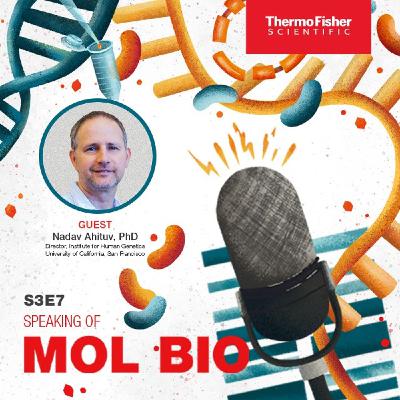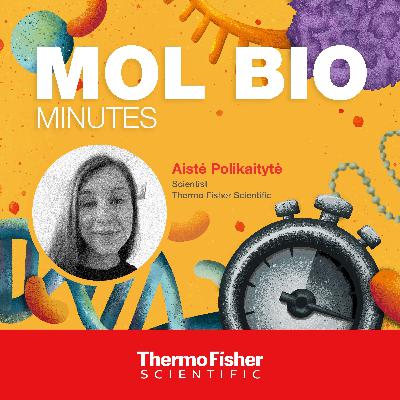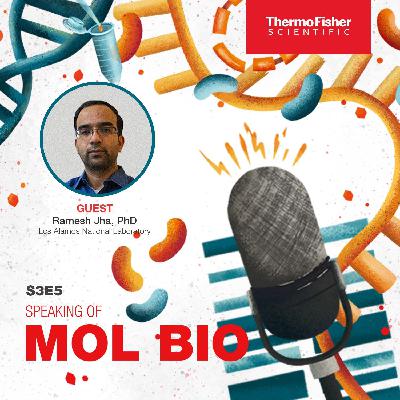Discover Speaking of Mol Bio
Speaking of Mol Bio

Speaking of Mol Bio
Author: Thermo Fisher Scientific
Subscribed: 112Played: 1,143Subscribe
Share
© 2025 Thermo Fisher Scientific
Description
Speaking of Mol Bio, a podcast series from Thermo Fisher Scientific, discusses trending applications in science and the molecular biology aspects of those applications. Our host delves in to deep discussion with CEOs, R&D scientists, researchers, and key opinion leaders across the globe. Speaking of Mol Bio helps scientific curious people - from all scientific and non-scientific backgrounds - understand how modern molecular biology applications can help push the boundaries in medicine, science, drug discovery, and in the cure and treatment of diseases.
Music from NOWHERE by ikson™ (https://www.iksonmusic.com)
Music from NOWHERE by ikson™ (https://www.iksonmusic.com)
43 Episodes
Reverse
In this episode of Speaking of Mol Bio, Dr. Andre Ghetti, CEO of AnaBios, offers a deep dive into the world of translational preclinical research. AnaBios is redefining early human insights by using ethically sourced, functional human tissues and cells to generate actionable data before compounds ever enter clinical trials. Ghetti walks us through the company’s approach of offering human-relevant safety and efficacy data, validating drug targets, and supporting everything from small startups to major pharma groups.We learn how AnaBios engages with clients to customize assays, especially in high-need areas like non-opioid pain therapies, fibrosis, and cardiac safety, and how they use a blend of standardized and novel functional assays, some of which required building their own hardware. He also discusses their integration of RT-PCR, RNA-seq, and calcium imaging, including genetically encoded sensors to monitor neuronal activity at scale.From their use of machine learning to analyze massive data sets, to collaborations with the FDA, to their unique ability to preserve tissue viability across the U.S., AnaBios offers a powerful glimpse into the future of translational biology. Dr. Ghetti also shares advice for young scientists and reflects on what’s next for AnaBios, including oncology and stem-cell model integration.
Subscribe to get future episodes as they drop and if you like what you’re hearing we hope you’ll share a review or recommend the series to a colleague. Visit the Invitrogen School of Molecular Biology to access helpful molecular biology resources and educational content, and please share this resource with anyone you know working in molecular biology. For Research Use Only. Not for use in diagnostic procedures.
In this Mol Bio Minutes episode, Thermo Fisher Scientific's Dr. Agnė Alminaitė unveils an exciting new approach for assay developers: Dry-Ready™ reagents for RT-LAMP and RT-qPCR. These innovations eliminate the need for lyophilizers by enabling air drying of molecular assays in a standard heating oven, producing room temperature-stable assays in under two hours.Agnė walks listeners through how Dry-Ready differs from traditional Lyo-Ready™ and lyophilization methods, while delivering similar stability and performance. She explains the critical role of thermostable enzymes and specially developed excipient mixes that protect enzyme function during the drying process.The episode introduces two new kits: the Dry-Ready™ RT-LAMP Kit, ideal for flexible assay development and point-of-care settings, and the one-step Dry-Ready™ RT-qPCR Kit, a powerful tool for simplified, dual-function reactions. Both kits are customizable and empower even small labs to stabilize assays without complex equipment.Whether you're commercializing a kit or looking to simplify your workflow, this episode offers actionable insight into next-generation assay stabilization. And don't miss the special promo code below!Helpful resource links mentioned in this episode:Learn more about air-drying and lyophilization for assay stabilization.Visit the product pages for the Dry-Ready products Agnė introduced:Invitrogen Dry-Ready™ RT-qPCR KitInvitrogen Dry-Ready™ RT-LAMP KitAccess all Thermo Fisher Scientific promotional offersAccess your exclusive Speaking of Mol Bio promotional offerEnter code “CAZDUA” if in the U.S.Enter code “CZ7F19” in in Canada
Subscribe to get future episodes as they drop and if you like what you’re hearing we hope you’ll share a review or recommend the series to a colleague. Visit the Invitrogen School of Molecular Biology to access helpful molecular biology resources and educational content, and please share this resource with anyone you know working in molecular biology. For Research Use Only. Not for use in diagnostic procedures.
In this inspiring episode, Dr. Felipe Gálvez-Cancino, group leader at Oxford's Center for Immuno-Oncology, walks us through his team’s groundbreaking research on macrophages, T cells, and immune regulation in solid tumors. Tracing his path from early cancer vaccine work to advanced antibody-dependent cellular phagocytosis (ADCP), Felipe shares how his team is working to reprogram tumor-associated macrophages to more efficiently eliminate cancer cells.He explains how regulatory CD4+ T cells suppress both T cell and macrophage responses within tumors and how removing that suppression can supercharge phagocytic function. We also hear how his lab is leveraging mouse models of hepatocellular carcinoma, clinical samples, and modern molecular biology techniques (like in vivo liver transfection and CRISPR-ready plasmid engineering) to study intratumor heterogeneity and antigen spreading.Felipe also reflects on the value of early molecular biology training—like mastering gigapreps—and emphasizes the importance of curiosity, persistence, and collaboration in scientific careers. Whether you’re interested in cancer biology, immunotherapy, or just passionate about translating discoveries into new therapies, this episode offers both technical depth and motivational insight.
Subscribe to get future episodes as they drop and if you like what you’re hearing we hope you’ll share a review or recommend the series to a colleague. Visit the Invitrogen School of Molecular Biology to access helpful molecular biology resources and educational content, and please share this resource with anyone you know working in molecular biology. For Research Use Only. Not for use in diagnostic procedures.
In this Mol Bio Minutes episode, Dr. Will Barnes, a plant biologist turned senior sales training specialist at Thermo Fisher Scientific, reflects on his time at the bench and the molecular lessons learned along the way. Will dives deep into the difficulties of RNA work in plant systems—carbohydrate contamination, genomic DNA carryover, secondary structure—and how these hindered everything from cloning and expression analysis to sequencing and qPCR.Through real-world anecdotes, he explains how high-quality reagents and systems helped him troubleshoot and resolve recurring issues, ultimately saving time and improving data reliability. He advocates for prioritizing upstream steps like RNA integrity and reverse transcription fidelity instead of chasing fixes at the end of the workflow.Listeners will leave with a deeper appreciation for the critical role of sample prep in molecular biology workflows and why investing in better tools pays off in cleaner data, greater confidence, and fewer headaches. Will’s experience is a relatable reminder that smarter choices lead to better science.Helpful resource links mentioned in this episode:Learn about molecular cloning workflows and Gateway cloning solutionsExplore a variety of resources on reverse transcriptionTaqMan vs SYBR Chemistry for Real-Time PCRUsing MagMAX kits for automated nucleic acid extractionLearn more about, or order,SuperScript IV VILO Master MixExplore RNA/DNA quantification solutions, including Qubit and Nanodrop instruments----------------------------------------------------------------------------------------------Limited time promotional offer – Be one of the first 75 listeners to spend $500 and get 40% off all eligible reverse transcriptase, plastics, enzymes, and cloning reagents. Visit thermofisher.com/sombpromo for full detailsEnter promo code CAZDUA in the U.S.A.Enter promo code CZ7F19 in Canada
Subscribe to get future episodes as they drop and if you like what you’re hearing we hope you’ll share a review or recommend the series to a colleague. Visit the Invitrogen School of Molecular Biology to access helpful molecular biology resources and educational content, and please share this resource with anyone you know working in molecular biology. For Research Use Only. Not for use in diagnostic procedures.
In this episode of Speaking of Mol Bio, host Steve Lewis speaks with Dr. Melissa Wu, co-founder and CEO of Seeding Labs, a nonprofit that’s redefining global scientific access. Dr. Wu shares the inspiring story of how Seeding Labs helps institutions in developing nations build research infrastructure by redistributing surplus laboratory equipment from partners like Thermo Fisher Scientific.With an innovative model that connects equipment donors in the global North with universities and institutes across Africa, Asia, and Latin America, Seeding Labs enables groundbreaking science in places where opportunity is limited but talent is abundant. Dr. Wu highlights examples like the Malawi University of Science and Technology, whose graduates are now staffing the country's first hospital microbiology labs, and a Beninese research team using donated PCR equipment to improve the yield of indigenous crops like the miracle berry.More than a logistics operation, Seeding Labs is also fostering scientific networks, reversing brain drain, and giving researchers confidence, courage, and agency. Dr. Wu offers a compelling vision of an equitable global scientific ecosystem, and shares how listeners can get involved—whether by donating equipment, funds, or simply spreading the word.
Subscribe to get future episodes as they drop and if you like what you’re hearing we hope you’ll share a review or recommend the series to a colleague. Visit the Invitrogen School of Molecular Biology to access helpful molecular biology resources and educational content, and please share this resource with anyone you know working in molecular biology. For Research Use Only. Not for use in diagnostic procedures.
In this Mol Bio Minutes mini-episode, Thermo Fisher Scientific’s Agnė Žiupkaitė takes listeners on a journey through the evolving world of RNA assay development—focusing specifically on 1-Step RT-qPCR. She outlines the critical considerations for assay developers, including enzyme speed, robustness, and the growing demand for customizable reagents that meet both technical and regulatory needs.Highlighting Thermo Fisher’s SuperScript reverse transcriptase family—particularly the Lyo-ready SuperScript III Flash RT—Agnė explains how innovations in enzyme design have broken past bottlenecks in assay workflow, enabling reverse transcription in under a minute. She also explores the power of customization, from labeling and fill formats to enzyme formulation changes and glycerol-free options that support microfluidic platforms and lyophilization.Agnė offers practical insight into how raw material suppliers can serve as collaborative partners, not just vendors. She emphasizes the importance of commercial rights, scalability, and regulatory readiness when sourcing components for commercial assay kits. Whether you're an OEM kit developer or a scientist building the next molecular breakthrough, this episode is packed with actionable insights to improve efficiency, reliability, and speed.Helpful resource links mentioned in this episode:Learn more about raw materials for molecular diagnosticsOrder Lyo-ready SuperScript III Flash TranscriptaseVisit this page to expand your knowledge of reverse transcription
Subscribe to get future episodes as they drop and if you like what you’re hearing we hope you’ll share a review or recommend the series to a colleague. Visit the Invitrogen School of Molecular Biology to access helpful molecular biology resources and educational content, and please share this resource with anyone you know working in molecular biology. For Research Use Only. Not for use in diagnostic procedures.
In this episode, host Steve Lewis sits down with Giovanna Prout, President and CEO of Scale Biosciences, to explore how Scale is pushing the boundaries of single-cell omics. With a career that spans roles with big players and entrepreneurial ventures, Giovanna brings a unique perspective to the world of genomics innovation.Giovanna dives into Scale's patented Quantum Barcoding technology—a high-throughput, combinatorial indexing approach that allows researchers to process millions of cells and thousands of samples simultaneously, all without the need for specialized instrumentation. She explains how this flexible, automation-friendly platform is opening doors for AI-driven data modeling, large-scale drug screening, and highly diverse patient cohort studies.Beyond the science, Giovanna reflects on her leadership journey, emphasizing persistence, servant leadership, and a passion for making a difference in life sciences. She also shares the vision behind the 100 Million Cell Initiative, a bold collaboration that empowers scientists to dream big without constraints. For early-career scientists, Giovanna offers candid advice on working hard, staying curious, and believing in the impact of their work.
Subscribe to get future episodes as they drop and if you like what you’re hearing we hope you’ll share a review or recommend the series to a colleague. Visit the Invitrogen School of Molecular Biology to access helpful molecular biology resources and educational content, and please share this resource with anyone you know working in molecular biology. For Research Use Only. Not for use in diagnostic procedures.
In this episode of Speaking of Mol Bio, Aistė Serapinaite, an experienced R&D scientist, shares her insights into the world of 1-Step RT-PCR—a method that simplifies RNA analysis by combining reverse transcription and PCR amplification in a single reaction. She explains how traditional RNA workflows once lengthy, multi-step processes were prone to errors and contamination, and how 1-Step RT-PCR has transformed this landscape with speed, efficiency, and fewer handling steps.Listeners learn about the technical workings of 1-Step RT-PCR, including the importance of primer design, RNA quality, and essential controls to ensure reliable results. Aistė highlights the Invitrogen SuperScript IV UniPrime One-Step RT-PCR System, emphasizing features like universal annealing temperatures and high sensitivity, capable of detecting even trace levels of RNA.The episode also explores diverse applications, from gene expression studies and cancer biomarker detection to monitoring viral pathogens such as SARS-CoV-2 and Zika virus. While acknowledging the limitations of 1-Step RT-PCR—like the inability to archive cDNA for future assays—Aistė affirms its role as a fast, robust, and eco-friendly solution for high-throughput molecular biology labs. Whether you're new to molecular workflows or an experienced researcher, this episode offers valuable tips and tools to optimize your RNA experiments.Helpful resource links mentioned in this episode:See how one-step RT-PCR is used for amplicon-based viral genome sequencingView a video on the differences between one-step and two-step RT-PCRAccess the Oligo Perfect Primer Designer toolOrder or check out the brochure for Invitrogen SuperScript IV UniPrime One-Step RT-PCR SystemOrder Invitrogen ezDNase Enzyme
Subscribe to get future episodes as they drop and if you like what you’re hearing we hope you’ll share a review or recommend the series to a colleague. Visit the Invitrogen School of Molecular Biology to access helpful molecular biology resources and educational content, and please share this resource with anyone you know working in molecular biology. For Research Use Only. Not for use in diagnostic procedures.
In this episode of Speaking of Mol Bio, Dr. Beth Webb takes us deep into the world of platelets, often misunderstood components of blood that punch far above their weight in both physiological and pathological processes. As a postdoctoral researcher at the University of Leeds, Dr. Webb explores how endothelial signals influence platelet activity, and how these anucleate cell fragments play roles not only in clotting, but also in immune responses, inflammation, and diseases like cardiovascular disorders and COVID-19.Beth unpacks the technical challenges of isolating and analyzing platelets—particularly in RNA sequencing and qPCR—while stressing the importance of sample purity and the presence of platelet subpopulations. The conversation also touches on the hope of personalized medicine through platelet-based diagnostics and tailored antiplatelet therapies.Beyond the lab, Dr. Webb is an active science communicator, sharing tips on engaging broader audiences through social media, blogs, and video. She emphasizes the importance of resilience, creativity, and starting small when communicating science. Whether you're a cell biologist, a hematology enthusiast, or a fellow communicator, this episode offers something for everyone.
Subscribe to get future episodes as they drop and if you like what you’re hearing we hope you’ll share a review or recommend the series to a colleague. Visit the Invitrogen School of Molecular Biology to access helpful molecular biology resources and educational content, and please share this resource with anyone you know working in molecular biology. For Research Use Only. Not for use in diagnostic procedures.
In this Mol Bio Minutes episode, Laurynas Alijošius shares a personal story that every molecular biologist can relate to—running PCR, cloning, and sequencing, only to discover frustrating errors in the DNA. This episode dives deep into PCR accuracy and why it matters for everything from sequencing to cloning and long-read library prep. Laurynas breaks down the major contributors to PCR error, including the fidelity of DNA polymerase, primer design flaws, template impurities, and suboptimal cycling conditions. He then offers a range of solutions—like switching to high-fidelity enzymes, using ready-to-go master mixes, and optimizing magnesium ion concentrations. He also explains how reducing cycle numbers and fine-tuning annealing temperatures can minimize unwanted amplification and ensure more reliable data.Whether you're troubleshooting or proactively optimizing your workflow, this episode is packed with tips and tools to help you increase PCR accuracy, reduce costs, and save time. Episode notes contain links to enzyme comparisons, primer design tools, and cycling guides to help you PCR with precision.Helpful resource links mentioned in this episode:Thermo Scientific web tools for primer design and analysis, and moreThe PCR Learning Center with lots of helpful tips and informationLearn more about PCR reagents and enzymesBrowse and purchase PCR enzymes and master mixesAccess the PCR troubleshooting guideDownload the molecular biology handbook
Subscribe to get future episodes as they drop and if you like what you’re hearing we hope you’ll share a review or recommend the series to a colleague. Visit the Invitrogen School of Molecular Biology to access helpful molecular biology resources and educational content, and please share this resource with anyone you know working in molecular biology. For Research Use Only. Not for use in diagnostic procedures.
In this episode of Speaking of Mol Bio, Dr. Cath Moore of the Australian Genome Research Facility (AGRF) discusses how molecular biology technologies are helping to shape Australia’s scientific landscape—from clinical genomics and conservation to bioremediation and agriculture. With over 20 years of experience in both academia and industry, Dr. Moore reflects on the remarkable evolution of genomic tools, from Sanger sequencing to high-resolution spatial multiomics.She unpacks AGRF’s mission to democratize access to emerging technologies and highlights its role as an early adopter of platforms that help scientists translate academic research into real-world impact. Topics include non-mass spec proteomics, mine site rehabilitation through soil microbiome analysis, and the role of systems biology in modern science.Dr. Moore also discusses the importance of community education and literacy around genomics, emphasizing how public understanding is key to the safe adoption of emerging technologies like synthetic biology. Finally, she shares career insights and advice for aspiring scientists: stay curious, stay broad, and don’t be afraid to pivot when your work no longer brings joy.
Subscribe to get future episodes as they drop and if you like what you’re hearing we hope you’ll share a review or recommend the series to a colleague. Visit the Invitrogen School of Molecular Biology to access helpful molecular biology resources and educational content, and please share this resource with anyone you know working in molecular biology. For Research Use Only. Not for use in diagnostic procedures.
In this Mol Bio Minutes episode, Laurynas Alijošius breaks down how to run fast PCR to save time and increase lab efficiency. He explains how to choose the right thermal cycler with fast ramp speeds, select low-volume and thin-walled PCR plastics, and use engineered DNA polymerases that offer rapid elongation and hot-start capability. Laurynas also covers practical tips for optimizing reaction components, shortening cycling protocols, and reducing waste. Whether you’re aiming to finish your experiment before dinner or streamline your workflow long-term, this episode delivers everything you need to master the art of fast PCR.Helpful resource links mentioned in this episode:Molecular biology handbook – An extensive resource for all things molecular biologyApplied Biosystems thermal cyclers – Including those that support fast PCRPCR consumables – Four key attributes to considerPCR plastics selection tool – Find the right plastics for your instrument and fast PCRDNA polymerases – Four key characteristics to know and considerPCR setup optimization – Six critical things to optimize for optimal PCR resultsEnzymes and master mixes – Get the right reagents to drive your PCR reactionCycling optimization – Instrument considerations for PCR success
Subscribe to get future episodes as they drop and if you like what you’re hearing we hope you’ll share a review or recommend the series to a colleague. Visit the Invitrogen School of Molecular Biology to access helpful molecular biology resources and educational content, and please share this resource with anyone you know working in molecular biology. For Research Use Only. Not for use in diagnostic procedures.
This episode teaches that innovation is born at the intersection of curiosity and persistence. Dr. Gudrun Stengel, co-founder and CEO of Alida Biosciences, reveals how her startup is transforming the landscape of RNA research through a novel technology called proximity barcoding. Dr. Stengel’s story exemplifies the power of entrepreneurial spirit in driving scientific discovery, offering a glimpse into how one idea can reshape an entire field.At Alida Biosciences, Dr. Stengel and her team are pioneering new tools for detecting RNA modifications, a largely unexplored realm of epigenetics. Using their proximity barcoding platform, researchers can read multiple RNA modifications simultaneously, uncovering potential biomarkers and therapeutic targets for diseases like cancer, Alzheimer’s, and diabetes. This technology bridges a critical gap in multiomics, allowing scientists to dive deeper into how epigenetic changes influence gene expression and cellular behavior.Beyond the lab, Dr. Stengel shares her experience as a first-time founder, balancing scientific rigor with startup life. From managing a team to fundraising, her journey underscores the importance of resilience, optimism, and maintaining a long-term vision. She also offers valuable advice for budding scientists, encouraging them to embrace challenges and remain persistent in the face of setbacks.
Subscribe to get future episodes as they drop and if you like what you’re hearing we hope you’ll share a review or recommend the series to a colleague. Visit the Invitrogen School of Molecular Biology to access helpful molecular biology resources and educational content, and please share this resource with anyone you know working in molecular biology. For Research Use Only. Not for use in diagnostic procedures.
Sustainability in the lab isn't just a trend—it's a responsibility. In this quick but powerful Mol Bio Minutes episode, sustainability expert Sune Lund Sporring shares actionable tips to reduce energy use, manage lab waste, and transition to greener materials like Thermo Fisher’s Sustain Series bio-based plastics.Discover the difference between bio-based and biodegradable, why second-generation feedstocks are a game-changer, and how to make low-impact changes without compromising performance. Learn how small shifts—like using aluminum beads instead of water in a bath or switching to carbon-reduced plastics—can significantly cut your lab’s carbon footprint. And remember: if greener options aren’t available, your demand can help shape the market.Helpful resource links mentioned in this episode:My Green Lab – Facts and resources about lab sustainabilityEnergy use of fume hoods – Energy use and savings ideas for fume hoodsGreener by Design – Thermo Fisher’s approach to green solutionsLab Armor™ Beads – A sustainable option to replace water in water bathsInstrument trade up program – trade in your equipment to be green and give it a second lifeLab plastic waste – Stats about plastic waste in labsDoing something about it – Thermo Fisher’s lower carbon plastics solutionSustain Series PCR plastics – Lower carbon footprint, without workflow interruptionReasons to believe – Fact sheet about Sustain Series PCR plastics
Subscribe to get future episodes as they drop and if you like what you’re hearing we hope you’ll share a review or recommend the series to a colleague. Visit the Invitrogen School of Molecular Biology to access helpful molecular biology resources and educational content, and please share this resource with anyone you know working in molecular biology. For Research Use Only. Not for use in diagnostic procedures.
Join us for an insightful conversation with Dr. Nadav Ahituv, a leader in human genetics and gene regulation at UCSF. He shares his personal journey from scoliosis patient to genetic researcher, exploring the mysteries of non-coding DNA, massively parallel reporter assays, and CRISPR-based therapeutic innovations.We dive into his lab’s diverse projects, from decoding bat wing development and diet adaptation to tackling complex diseases like scoliosis and cancer through gene modulation. Learn how cloning is used alongside technologies like AI, genome-wide sequencing, and CRISPR to revolutionize our understanding of regulatory elements and shape the future of precision medicine.Plus, discover how a surprising approach—using modified fat cells—could be a game-changer in cancer therapy. This episode is a must-listen for anyone fascinated by the intersection of genetics, technology, and evolution.
Subscribe to get future episodes as they drop and if you like what you’re hearing we hope you’ll share a review or recommend the series to a colleague. Visit the Invitrogen School of Molecular Biology to access helpful molecular biology resources and educational content, and please share this resource with anyone you know working in molecular biology. For Research Use Only. Not for use in diagnostic procedures.
With prior Mol Bio Minutes episodes covering DNA form migration and staining considerations for nucleic acid gel electrophoresis, we tie it all together with this great set of overall tips, tricks and resources for the topic. Anyone that’s ever run a gel has undoubtedly produced gels with smeared, faint or poorly separated bands. What causes these and how can you avoid them? Well, Aistė Polikaitytė, Scientist at Thermo Fisher Scientific is here to cover the likely causes and troubleshooting tips to help avoid the most common gel issues. She touches on how much sample to load, the importance of reagent selection, gel preparation, separation conditions, staining, as well as purification and contamination considerations. Helpful resource links mentioned in this episode:Selection guide for electrophoresis dyes and buffersLearn how using precast E-Gel agarose gel can help avoid common issuesA helpful troubleshooting guide for nucleic acid gel electrophoresisView an on-demand webinar covering these topics in more detail
Subscribe to get future episodes as they drop and if you like what you’re hearing we hope you’ll share a review or recommend the series to a colleague. Visit the Invitrogen School of Molecular Biology to access helpful molecular biology resources and educational content, and please share this resource with anyone you know working in molecular biology. For Research Use Only. Not for use in diagnostic procedures.
It could be argued that biology has always boiled down to chemistry, and that chemistry has always boiled down to physics. However, not many would deny that the fields of biology and chemistry are overlapping more than ever, with both leveraging computing methods, also more than ever. This conversation with Dr. Ramesh Jha, Technical Staff Member at Los Alamos National Laboratory (LANL), crosses biology, chemistry, and computing methods. The work of his biome team at LANL uses computational tools to inform the design of enzymes that are produced via PCR-based cloning and then expressed in microbes. They use fluorescent gene circuits in these microbes, along with flow cytometry, to screen these large libraries for advantageous gain-of-function variants. When they find an interesting mutation, they isolate it, sequence it, and produce and evaluate those biocatalytic enzymes for bioremediation, biomanufacturing, and other important applications. Ramesh makes this complex and interdisciplinary science approachable and gives hope to how it could help address problems of “forever chemicals” and other environmental and manufacturing challenges. Join us for this interesting and inspiring conversation.
Subscribe to get future episodes as they drop and if you like what you’re hearing we hope you’ll share a review or recommend the series to a colleague. Visit the Invitrogen School of Molecular Biology to access helpful molecular biology resources and educational content, and please share this resource with anyone you know working in molecular biology. For Research Use Only. Not for use in diagnostic procedures.
You can run the perfect agarose gel to separate your nucleic acid fragments but if you don’t stain and image the gel properly, it’s all for not. In this second installment of Mol Bio Minutes we take a look at the staining considerations for nucleic acid gel electrophoresis with Paulius Palaima, Product Manager at Thermo Fisher Scientific. He covers the range of stains and staining approaches available while calling out pros, cons and considerations for each. How these recommendations change, depending on your sample, is also covered in this approachable but informative episode. Helpful resource links mentioned in this episode:A helpful DNA stain selection guideRNA stain options and detailsEffects of dyes on gel electrophoresis properties
Subscribe to get future episodes as they drop and if you like what you’re hearing we hope you’ll share a review or recommend the series to a colleague. Visit the Invitrogen School of Molecular Biology to access helpful molecular biology resources and educational content, and please share this resource with anyone you know working in molecular biology. For Research Use Only. Not for use in diagnostic procedures.
Topics and terms such as biosafety, biosecurity, containment, and contamination are things most of us have heard of and think about at some level, but with the pace of molecular biology moving faster than ever, these are topics with implications that are reaching farther than ever. We’re joined by Dr. Ryan Burnette and Dr. Lauren Richardson from Merrick and company for this episode, and they’re ace communicators that help walk us through the expanding horizon and implications of these topics.This conversation starts on the basic topics, like what biocontainment is and what’s needed for each of the four levels of biosafety labs, but it quickly moves beyond, shining a light on the security and containment needs for more than just the organisms. We hear about how the data and methods used to do modern molecular biology, as well as the data generated in the experiments, are equally precious and in need of protection and containment. With public health and safety on the line, and an acknowledgement that the pace of science moves faster than that of policy, we get into the idea of who really owns responsibility for protecting data. Your role might be more important than you know, so don’t miss this conversation that will make you pause and think!
Subscribe to get future episodes as they drop and if you like what you’re hearing we hope you’ll share a review or recommend the series to a colleague. Visit the Invitrogen School of Molecular Biology to access helpful molecular biology resources and educational content, and please share this resource with anyone you know working in molecular biology. For Research Use Only. Not for use in diagnostic procedures.
Agarose gel electrophoresis is a staple method in almost all biology and biochemistry lab where separation and analysis of nucleic acids is needed. In this Mol Bio Minutes mini episode Augustė Užuotaitė, Scientist III at Thermo Fisher Scientific, covers the basics of electrophoresis with a spotlight on how different forms of DNA migrate differently in agarose gel electrophoresis.In less than 10 quick minutes, you’ll learn about the many factors that affect DNA migration rate. Augustė reviews how DNA size, sequence, and conformation all affect migration rate, and she gives some beautifully simple examples to help it all make sense. Helpful resource links mentioned in this episode:Nucleic acid gel electrophoresis – summarized in 5 easy stepsFive important considerations for the nucleic acid gel electrophoresis
Subscribe to get future episodes as they drop and if you like what you’re hearing we hope you’ll share a review or recommend the series to a colleague. Visit the Invitrogen School of Molecular Biology to access helpful molecular biology resources and educational content, and please share this resource with anyone you know working in molecular biology. For Research Use Only. Not for use in diagnostic procedures.





